How To Disinfect a Car
September 14, 2021
Cars have many nooks and crannies, openings, and crevices that are tough to clean. They have different types of surfaces, and some vehicles are even more challenging to clean and disinfect than our own homes.
So it's important to know which spots need that extra attention since our rides can be germier than a toilet seat. We're not kidding. You'll see this reference a lot. Depending on what you're using your car for, you might have to clean and disinfect it consistently, more so than others.
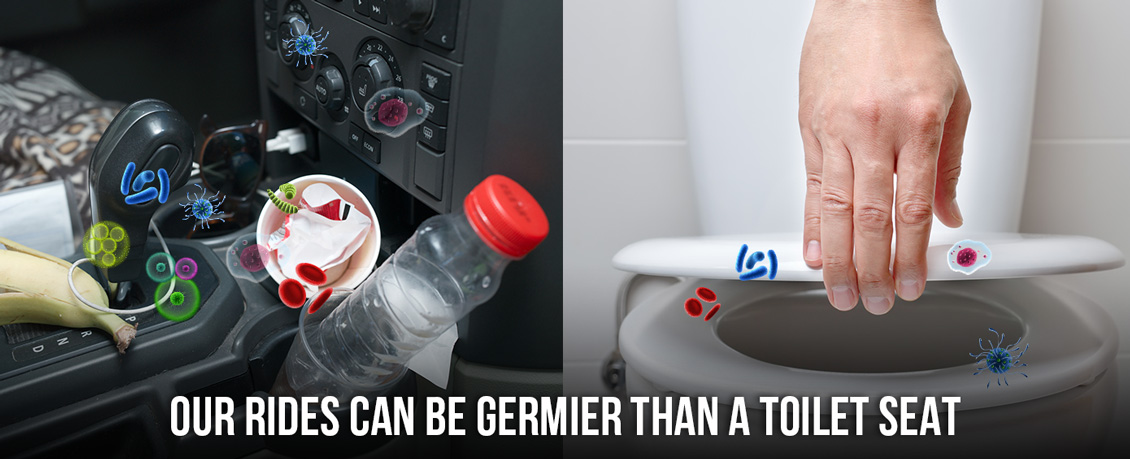
We'll go over some very interesting facts and studies about these germs that don't deserve a free ride and then give you a step-by-step guide on how to disinfect a car properly.
Once we show you these germy stats, you'll see that depending on whether you drive a family or personal vehicle, drive for Uber and Lyft, own a taxi, or drive a rental, the focus of your disinfecting efforts varies.
How Germy Are Cars in General?
Do you know how often people clean their cars? Not often enough.
In a survey done by
CarRentals.com, 32% out of the 1000 car owners they surveyed said that they clean their vehicle's interior only once a year, and 12% never do it!
Maybe before COVID, we wouldn't have added an exclamation point for that last stat, but we're more germ-conscious these days.
Still, generally speaking, cars aren't all that dirty, right? Wrong!
According to the
National Center for Biotechnology Information (NCBI), a car's interior can be dirtier than a toilet seat. That fact seems like a good reason to run to your ride right now for a nice scrub down.
If you think that's an exaggeration, we'll show you just how much dirtier than a truck stop bathroom personal cars, ridesharing vehicles, taxis, and rentals can be.
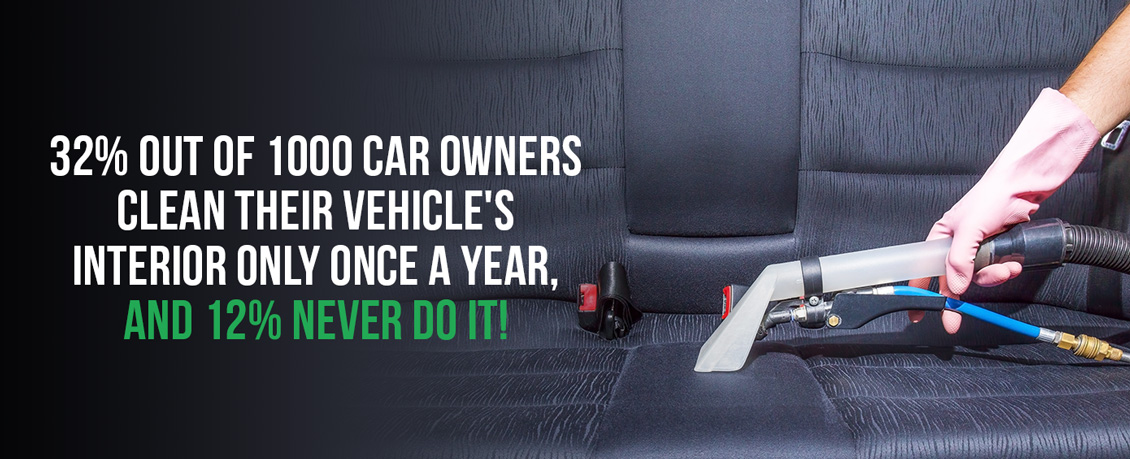
Note: the following numbers are expressed in Colony-Forming Units or CFUs, referring to the estimated number of active microorganisms in a sample. We'll be mentioning the number of CFUs per square centimeter (per sq. in.) on surfaces.
Germ Levels in Your Ride
Just because you don't work as an Uber driver, it doesn't mean your car isn't packing lots of germs. The fact is,
your steering wheel is probably dirtier than a toilet seat. How much more so? Here's what they found in that
CarRentals.com study.
The average public toilet seat has 172 CFUs per sq. in., whereas your average steering wheel has 629 CFUs per sq. in. That's four times dirtier than the average porcelain throne. It doesn't get better for your average cupholders or seatbelts, either. Those numbers are clocking an average around of 506 and 403 CFUs per sq. in., respectively. Is all this information about
germs in your car driving you crazy?
Well, vacuuming and scrubbing your interior down with dish soap and water just won't cut it in the long-term game. But don't worry. In a few moments, we'll explain how to disinfect a car and provide extended protection so you can drive in peace. But first, you should know that different types of germs are commonly hitching a ride in your car.
The Germs in Your Ride
The study we mentioned earlier by the NCBI found that there could be around
700 different bacteria strains inside your vehicle. The two most common are staph bacteria, including MRSA, and Propionibacterium, which can cause inflammation and skin infections.
If you use your vehicle for Uber or Lyft, rent it out, or work as a taxi driver, then things will only get germier from here.
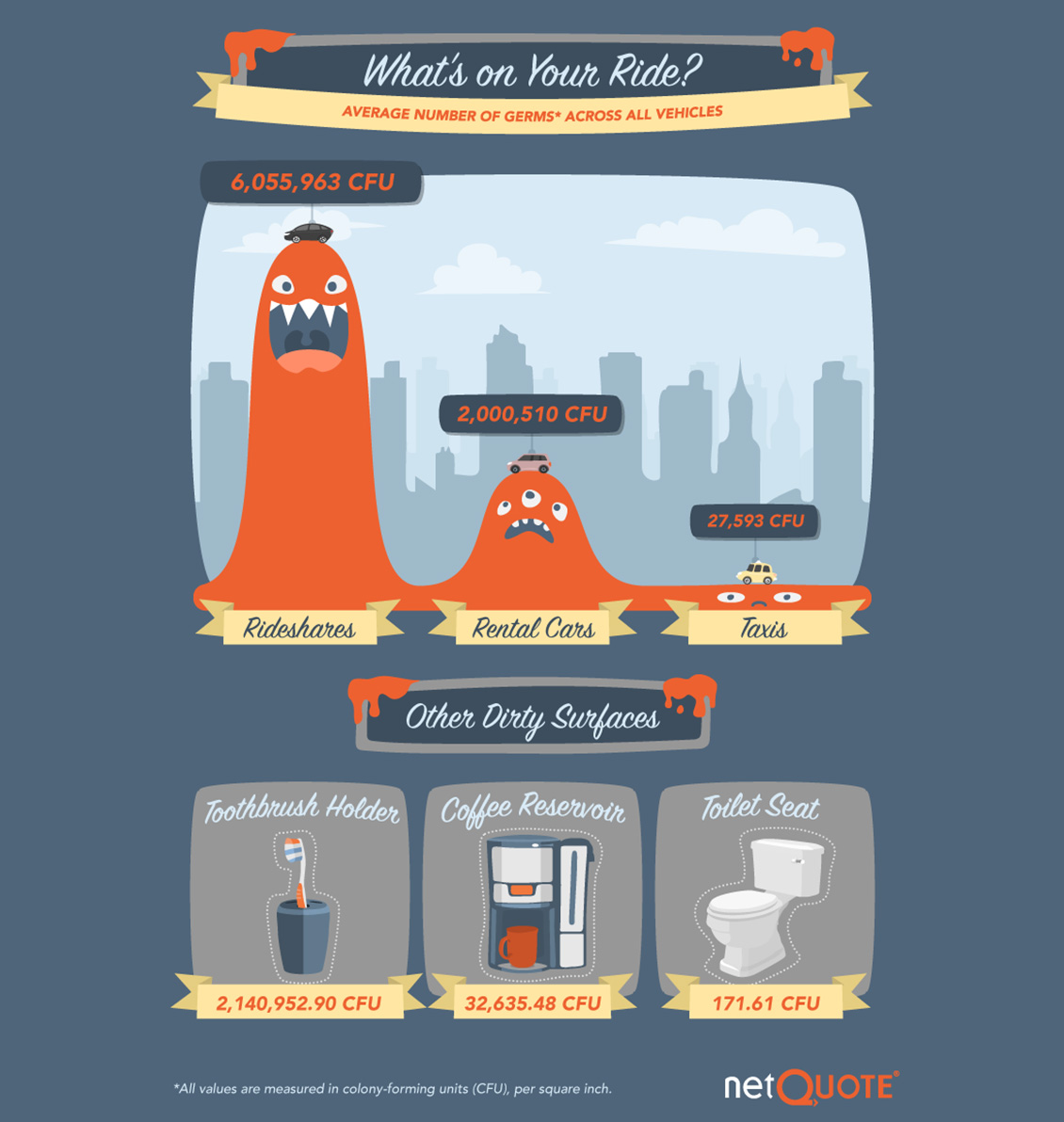
Germ Levels in Taxis
Could you be riding with germs every time you hop into a taxicab? Obviously, yes, you most likely are. The real question is, how many? This study by NetQuote compared taxis, rideshare vehicles, and rental cars to show how the concentration levels of germs varied within the interior of these cars.
Surprisingly, taxis are less germier than rideshare vehicles and rentals, but more so than your own car. And that makes sense. Not everyone has a ton of people entering and exiting their rides daily.
Anyways, the overall surfaces they tested inside the taxis had an average of 27,000 CFUs per sq. in. of germs. The germiest surfaces, to the least, were the seatbelts averaging 26,000 CFUs per sq. in., door handles were around 1,570 CFU per sq. in., and the window buttons averaged 23 CFUs per sq. in of germs.
Guess you could say only the window buttons in a taxi are less germier than a toilet seat. But what kinds of germs are commonly found inside taxis?
Germs Found in Taxis
That study by NetQuote revealed that the most common germs found in taxis are gram-positive cocci. They accounted for 65% out of the 100% of other types of germs found inside cabs.
For those of us without a microbiology degree, we believe one example is good enough to show what those are. An example of a
gram-positive cocci is staph bacteria. Staph is a well-known bacteria that also includes
MRSA, which is resistant to antibiotics.
The study found that the other 29% of the germs inside taxis were gram-negative rods. One infamous example would be
E. coli. Bacteria in this family can cause bloodstream infections and pneumonia.
The last microorganism they found was yeast with only 5%, and it's the least of your worries.
If you own a yellow cab, now you know what types of germs are commonly found inside them. You also know what parts of the interior have a higher concentration of germs. So you know exactly where to focus your disinfecting efforts, and you can jump right into the step-by-step section on how to do this.
If you own a rental car company or using a rental for an extended period, keep reading.
Germ Levels in Rentals
We are mentioning the least to the germiest of motor vehicles. So, if you drive for Uber and Lyft, skip right ahead to see those numbers. NetQuote found that the rental cars they tested had a little over 2 million CFUs per sq. in of germs living in the interiors.
The germiest spot in rental cars is the shifter knob with 1,000,093 CFUs per sq. in., closely followed by the steering wheel with 1,000,013 CFUs per sq. in.
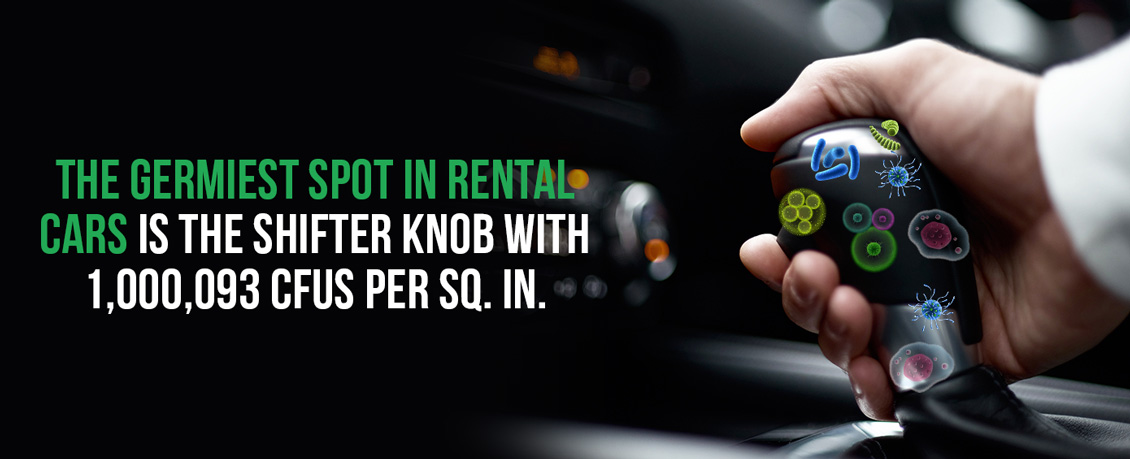
The cleanest? The seat belts, with only 403 CFUs per sq. in. Compare that to taxis and it's like they switched places.
Now, are the germs found in rentals the same types and at the same levels as what we found in taxis? Let's find out.
Germs Found in Rentals
NetQuote found that the rental car interiors were home to mostly 50% gram-negative rods and 50% gram-positive cocci.
Compared to the other vehicles, the rentals didn't really have such a diverse germy ecosystem compared to taxis and rideshares. But they did find a smaller population of other kinds of germs on the seatbelts.
The seatbelts they tested had yeast levels of up to 48% and actually found 46% of gram-positive rods and a tiny population of bacilli bacteria.
The type of germ they found crawling on the steering wheel were 100% only gram-negative rods, and the shifter knob had 100% gram-positive cocci.
If you're renting a car, make sure you disinfect the steering wheel first, wipe down that seatbelt and spray down that shifter knob.
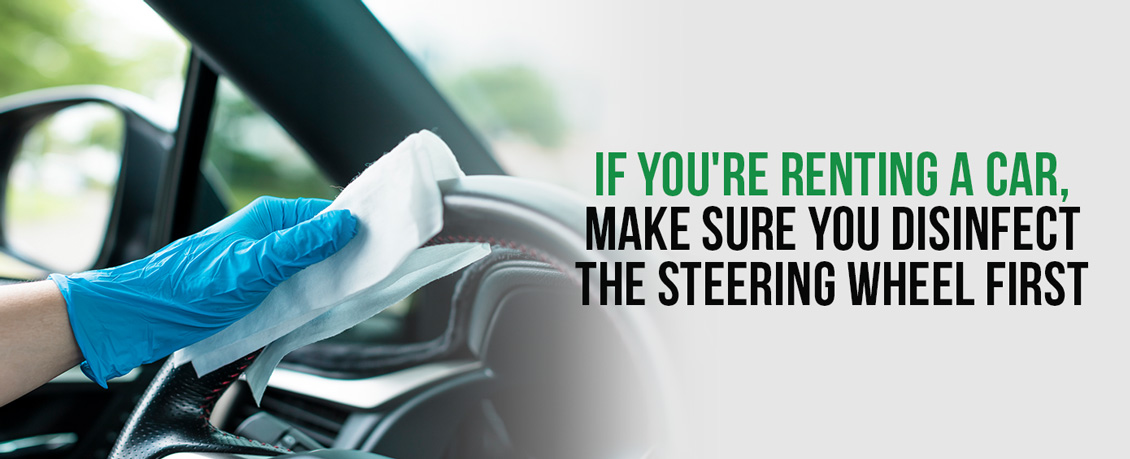
Have you been biting your nails because you drive for Lyft and Uber? Don't worry. Our step-by-step tutorial on how to disinfect a car is next after we go over this last section.
Germ Levels in Rideshares
Rideshares tested a little over 6 million CFUs per sq. in. on average. Which, if you ask us, is very scary.
Shockingly, the germiest spots on the rideshares NetQuote tested were not the steering wheel, nor the gearshift, not even the door handle. It was the window buttons that harbored more than 5 million CFUs per sq. in of germs. This makes us wonder, why does everyone in an Uber or Lyft lower their windows so much?
In any case, the seatbelts are in second place with more than 1 million CFUs per sq. in of germs. And the cleanest surface? The winner is the door handles which is home to 1,810 CFUs per sq. in of germs.
Now, let's go over the types of germs they found inside ridesharing vehicles one more time.
Germs Found in Rideshares
On those surprisingly germy window buttons, there was an almost an equal distribution of yeast, gram-positive rods, and gram-negative rods with 20% each, and 40% were made up of bacillus.
Next are the seatbelts, which were full of gram-negative rods hitting levels of up to 95%. As for the door handles, more than half were gram-positive cocci, and less than a third were bacillus.
We don't want to scare you, but let's give you an example of bacillus. This bacteria type is widely believed to have caused the fifth and sixth plagues of Egypt.
B. anthracis, which causes the anthrax disease, is a type of
bacillus bacteria; this doesn't mean that all rideshares' window buttons have anthrax. Really, these buttons normally contain the type of bacillus that can cause "infections and food poisoning," according to NetQuote.
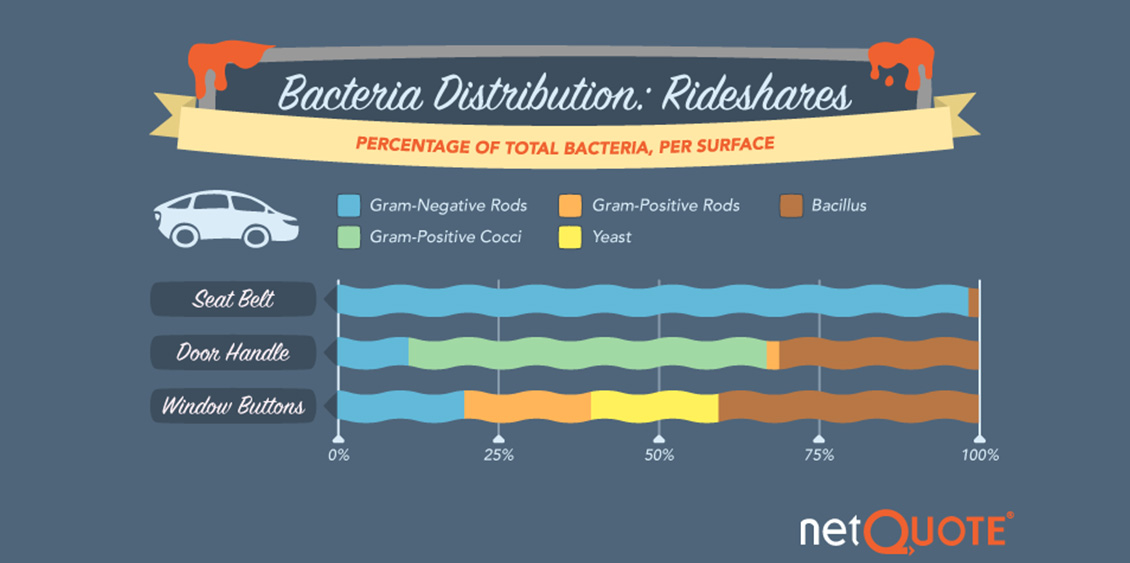
By this point, we bet you have a pretty good picture of just how big of a problem of germs in cars can be. Plus, with the information we just told you, you can be sure you are hitting the germiest spots in your car when you're disinfecting it. Since all you need now is the step-by-step guide on how to disinfect a car, let's get to it!
How To Disinfect a Car Step-by-Step
- The first thing you need to do is put on some protective gear. Wear a face mask and put on plastic gloves. You don't want to intake anything in that's not the air you breathe, and you should protect your hands.
- The second thing you need to do is remove all personal items and floor mats.
- Thirdly, you need to vacuum the carpets, seats, and the whole interior. Also, make sure you don't forget the floors and the floor mats you just took out of the car. Those need to be cleaned, vacuumed and disinfected too.
According to carpages.ca, "…Dirt can make it harder for your disinfectants to do their job." So, make sure your car is nice and clean before moving to the next step.
- Now, for the actual disinfecting, we recommend choosing a product that does not damage the surfaces inside your car's interior.
Our HOCl (hypochlorous acid) solutions can be used to disinfect the interior of your car without damaging and discoloring your surfaces. No harmful odors will be produced as well. And to make sure you reach all those nooks and crannies, you can use the Aeras-Mini powered by Aer-Force Technology, which is perfect for automobiles.
The AERAS-mini is a cordless unit chargeable via any standard electrical outlet or with a USB port. The tank for the AERAS-mini is easy to install, holds up to 20 ounces of our preferred HOCl solution, and is completely dishwasher safe. Plus, it maintains an electrostatic charge on particles for 10 seconds (3x the competition) but at a 68% lower cost than others.
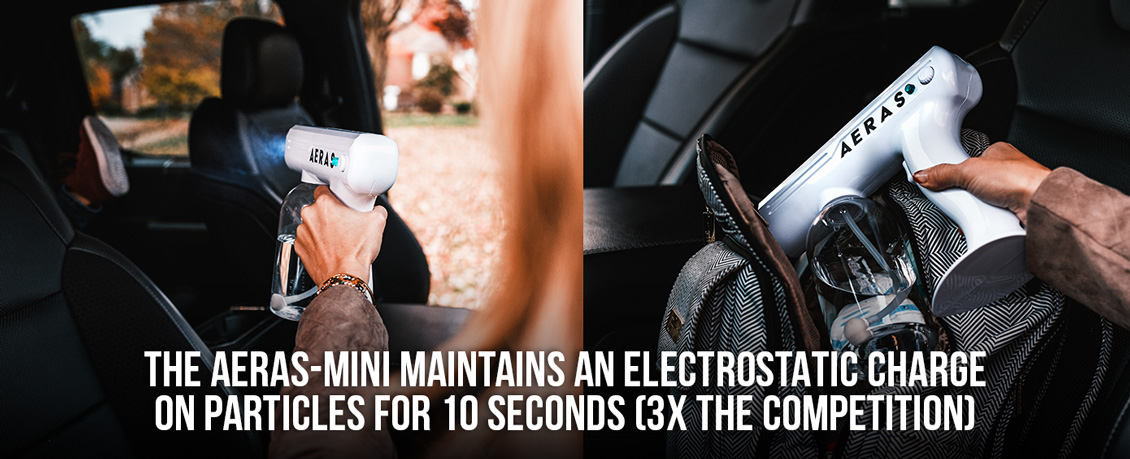
This handheld unit effectively covers surfaces and surrounding areas by electrostatically charging the deployed particles and allows our HOCl solution to uniformly wrap surfaces ensuring complete coverage.
Note: To disinfect your car without damaging it, if you have leather seats, it's important to stay away from chemicals like bleach or hydrogen peroxide (found in common cleaning products). The best you can do to make sure you don't damage your leather seats is to clean, sanitize, and disinfect them with products made specifically for leather.
- After applying our HOCl solution, make sure you let it dwell for 10 mins to work effectively. Then you can turn the car on and put the A/C on high and on recirculating mode. Let it run for a few minutes until the HOCL evaporates for faster dry times.
- Congratulate yourself because you're all set to go!
Yet, what if we could help you reduce the number of times you go through this whole process, and still reduce over 99% of many surface and airborne contaminants?
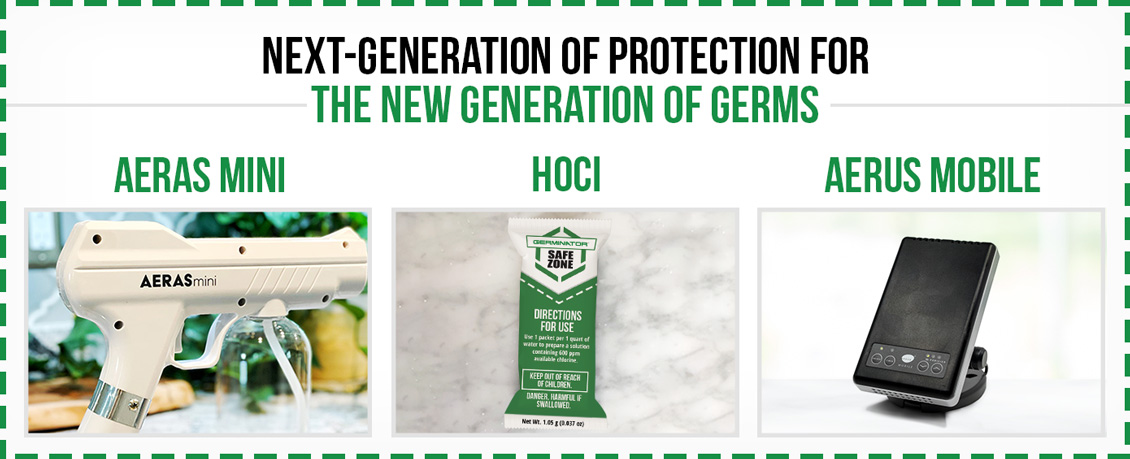
Well, the
Aerus Mobile with new and improved patented ActivePure cells reduces over 99% of many surface and airborne contaminants faster. Here is
scientific proof and a full list of pathogens and test data on ActivePure technology, including testing completed in August 2020 (surface) and December 2020 (airborne) that has shown remarkable levels of reduction in the virus that causes COVID.
The Aerus Mobile has touch-sensitive settings to provide ease of operation and function, and it comes with both a 12-volt D.C. car adapter and a 100-240-volt, 50/60 Hz AC adapter with interchangeable plugs.
It's the perfect solution to keep your car disinfected and complements the step-by-step disinfection process we mentioned earlier in a way that you shouldn't have to do it as often.
Germinator's mission is to provide 360 degrees of antimicrobial protection for surfaces, air, and you. This is why we have selected the best solutions to disinfect a place where people usually spend three full years of their life, and where germs are an afterthought.
We threw in that last fact for fun, but it makes you think how long we spend with invisible riders daily. According to
AAA, "U.S. drivers spend nearly an hour behind the wheel each day." We spend on average 3.2 years behind the wheel.
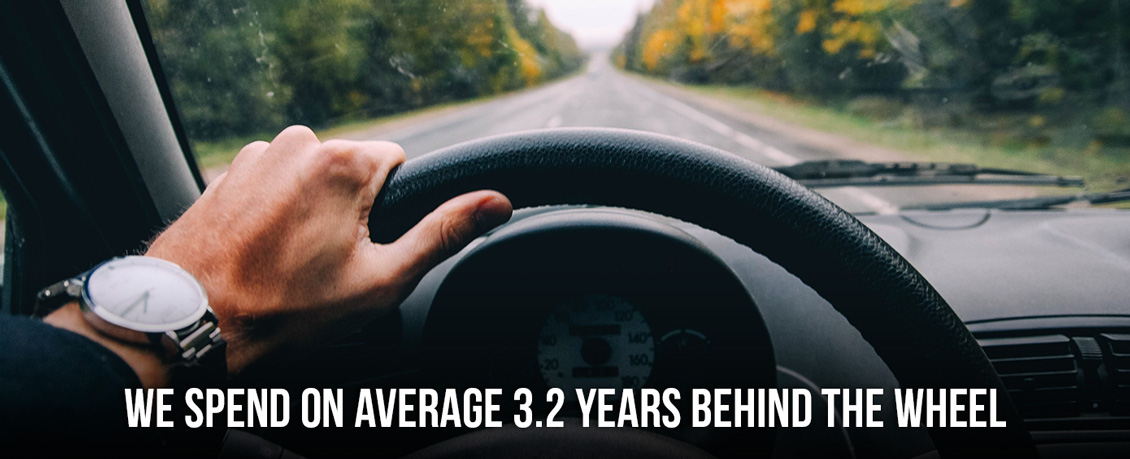
So, we want to ask you. Is your car in the Germinator Zone?
Check out our
Germinator Zone solutions page for more information about our surface, air, and body solutions. You can also call us at
855-NO-GERMZ (664-3769) or fill out the form here on our website to make sure your car is in the Germinator Zone!








